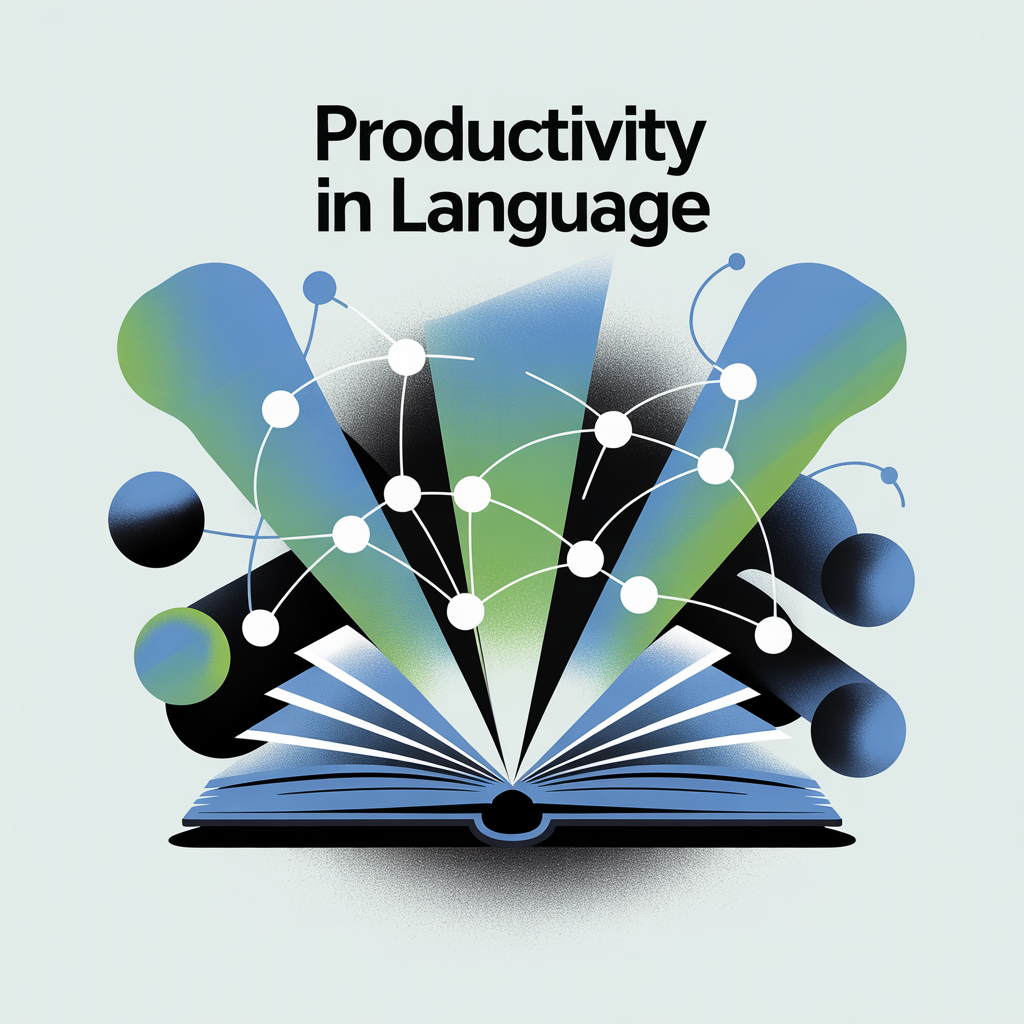Productivity in language is a fundamental aspect of human communication that allows individuals to generate and understand an infinite number of sentences using a finite set of words and grammatical rules. This remarkable ability sets human language apart from other forms of communication found in nature. The capacity to be productive in language enables individuals to express new ideas, create novel sentences, and adapt linguistic patterns to different contexts.
Understanding the mechanisms behind linguistic productivity is crucial for enhancing communication, learning new languages efficiently, and improving cognitive abilities related to speech and comprehension. The study of “productive linguistics” sheds light on how humans develop and use language in a structured yet flexible manner. From cognitive psychology to sociolinguistics, multiple disciplines contribute to understanding how language functions productively. This article explores various aspects of productivity in language, its psychological implications, and how individuals can enhance their linguistic proficiency to communicate more effectively in personal and professional settings.
Understanding Productivity in Language
What is productivity in language? Productivity in language refers to the ability to create and comprehend an unlimited number of sentences by applying grammatical structures and vocabulary in different combinations. This concept is fundamental in linguistics and cognitive science as it highlights the creative and generative nature of human language. Unlike fixed communication systems used by animals, human language is dynamic, adaptable, and capable of expressing abstract concepts.
Linguistic productivity is evident in everyday conversations where speakers effortlessly form new sentences they have never encountered before. It also plays a crucial role in language acquisition, as children learn to apply rules to construct sentences rather than merely memorizing fixed phrases. The study of productivity in language helps researchers understand how language evolves and how it can be effectively taught in educational settings.
The Cognitive Aspects of Linguistic Productivity
The human brain possesses an extraordinary ability to recognize patterns, infer meanings, and generate new linguistic structures based on existing knowledge. “Productive language psychology definition” refers to the cognitive processes involved in producing and understanding new sentences. Cognitive psychology examines how individuals store linguistic information, retrieve words from memory, and apply grammatical rules to form coherent speech.
Neurological studies suggest that productivity in language is facilitated by various brain regions, including Broca’s area and Wernicke’s area, which are responsible for language production and comprehension. These regions work together to process syntax, semantics, and phonetics, enabling individuals to construct meaningful and grammatically correct sentences.
Furthermore, cognitive flexibility plays a vital role in linguistic productivity, allowing speakers to switch between languages, adapt their speech to different contexts, and creatively use metaphors, idioms, and slang. Developing cognitive flexibility through language learning can enhance problem-solving skills and overall intelligence.
The Role of Grammar in Language Productivity
Grammar serves as the foundation of linguistic productivity, providing the structural framework that governs how words and phrases are combined. Without grammar, communication would be chaotic and ambiguous. The concept of “productivity linguistics” explores how grammatical rules enable speakers to create an infinite number of expressions while maintaining clarity and coherence.
Morphology, syntax, and phonology are key components of grammar that contribute to productivity in language. Morphology deals with word formation, allowing new words to be created through affixation, compounding, and blending. Syntax determines sentence structure, ensuring that words are arranged meaningfully. Phonology governs sound patterns, affecting pronunciation and intonation.
By mastering grammar, individuals can expand their linguistic repertoire and improve their ability to communicate effectively. This is especially important for language learners who need to internalize grammatical rules to produce grammatically correct and contextually appropriate sentences.
The Evolution of Productivity in Language
Language is not static; it evolves continuously as societies change and new forms of communication emerge. Historical linguistics examines how languages develop over time, leading to the creation of new words, phrases, and grammatical structures. The evolution of productivity in language is influenced by cultural exchanges, technological advancements, and social interactions.
For instance, the rise of the internet and digital communication has introduced new linguistic phenomena such as emojis, acronyms, and internet slang. These elements demonstrate the adaptability of language, as speakers incorporate novel expressions into their daily communication. The flexibility of language ensures its relevance and effectiveness in conveying meaning across different generations and cultural contexts.
Furthermore, language contact between different linguistic communities leads to borrowing, code-switching, and the development of hybrid languages. These processes highlight the creative and productive nature of human language, allowing it to remain dynamic and responsive to societal changes.
The Importance of Productivity in Second Language Acquisition
Learning a new language requires an understanding of linguistic productivity to develop fluency and proficiency. “What is productive language” in the context of second language acquisition refers to the ability of learners to generate original sentences using acquired vocabulary and grammar. Instead of merely memorizing set phrases, language learners must develop the skills to apply linguistic rules creatively.
Research in applied linguistics suggests that productive language use is essential for achieving communicative competence. Strategies such as active engagement in conversations, immersion in authentic language environments, and exposure to diverse linguistic inputs enhance productivity in language learning.
Moreover, language learners benefit from interactive methods such as role-playing, storytelling, and language games, which encourage spontaneous speech production. By focusing on productivity, learners can achieve greater confidence and express themselves more naturally in their target language.
The Connection Between Language Productivity and Creativity
Linguistic productivity is closely linked to creativity, as both involve the ability to generate new and meaningful expressions. Creative language use is evident in literature, poetry, humor, and rhetorical devices, where speakers manipulate language innovatively to evoke emotions and convey deeper meanings.
Metaphors, idioms, and wordplay exemplify the creative potential of language. Writers and poets use these linguistic tools to craft compelling narratives and evoke imagery that resonates with readers. Similarly, humorists employ puns and satire to entertain and critique social issues.
Developing linguistic creativity enhances communication skills and allows individuals to engage more effectively in storytelling, persuasive writing, and public speaking. Encouraging creativity in language use fosters critical thinking and enriches personal expression.
The Role of Technology in Enhancing Linguistic Productivity
Advancements in technology have revolutionized language use, making communication more efficient and accessible. Digital tools such as speech recognition software, machine translation, and language learning apps facilitate productivity in language by assisting users in acquiring, processing, and producing language.
Artificial intelligence (AI) and natural language processing (NLP) have also contributed to linguistic productivity by enabling chatbots, virtual assistants, and automated content generation. These technologies assist individuals in overcoming language barriers and improving their communication skills.
Furthermore, social media platforms serve as dynamic spaces for language innovation, where users create and share new expressions, hashtags, and internet slang. The interactive nature of digital communication encourages linguistic experimentation and adaptation, reflecting the evolving nature of language.
The Social and Cultural Impacts of Linguistic Productivity
Language is deeply intertwined with culture, shaping how individuals express their identities and interact with others. Productivity in language plays a crucial role in preserving cultural heritage, fostering social cohesion, and promoting intercultural communication.
Sociolinguistic studies reveal that linguistic productivity varies across communities based on social norms, traditions, and historical influences. Dialects, regional accents, and linguistic variations contribute to the richness of language, allowing individuals to convey cultural nuances effectively.
Additionally, multilingualism enhances productivity in language by enabling individuals to navigate diverse linguistic environments. Bilingual and multilingual speakers demonstrate cognitive advantages such as improved problem-solving abilities, enhanced memory, and greater adaptability in communication.
Strategies for Improving Productivity in Language
To enhance productivity in language, individuals can adopt various strategies that promote linguistic fluency and flexibility. These include:
- Expanding Vocabulary – Regularly learning new words and phrases broadens linguistic expression and prevents redundancy in speech and writing.
- Practicing Active Listening – Engaging with diverse linguistic inputs, such as podcasts, audiobooks, and conversations, improves comprehension and sentence formation.
- Engaging in Conversations – Speaking with native speakers and participating in discussions enhance spontaneous language production.
- Writing Regularly – Journaling, blogging, and creative writing refine language skills and encourage productive use of grammar and vocabulary.
- Using Language Learning Tools – Apps, flashcards, and online courses provide interactive ways to reinforce linguistic concepts.
- Immersing in the Target Language – Exposure to authentic materials, such as movies, books, and songs, fosters natural language acquisition.
By implementing these strategies, individuals can strengthen their linguistic productivity and communicate more effectively in various contexts.
Conclusion
Productivity in language is a fundamental characteristic that enables individuals to express thoughts, convey emotions, and engage in meaningful interactions. Understanding “what is productivity in language” provides insights into the cognitive, grammatical, and social aspects of linguistic expression. From second language acquisition to technological advancements, multiple factors contribute to enhancing linguistic productivity.
By mastering “productivity linguistics” and embracing creative language use, individuals can improve their communication skills and navigate diverse linguistic environments with confidence. Language remains a powerful tool for connection, learning, and cultural exchange, demonstrating its limitless potential for productivity and innovation.
ProlificFocus is your hub for improving focus, boosting productivity, and unlocking a consistent state of flow. Whether you’re managing ADHD, cultivating your creativity, or striving for a regular writing routine, ProlificFocus provides practical tools, thoughtful strategies, and valuable insights to help you stay on track. Our mission is to guide you through distractions, strengthen your priorities, and support meaningful, purpose-driven work. With an emphasis on clarity, balance, and long-term growth, ProlificFocus empowers you to create intentionally and reach your full potential—one focused step at a time.




